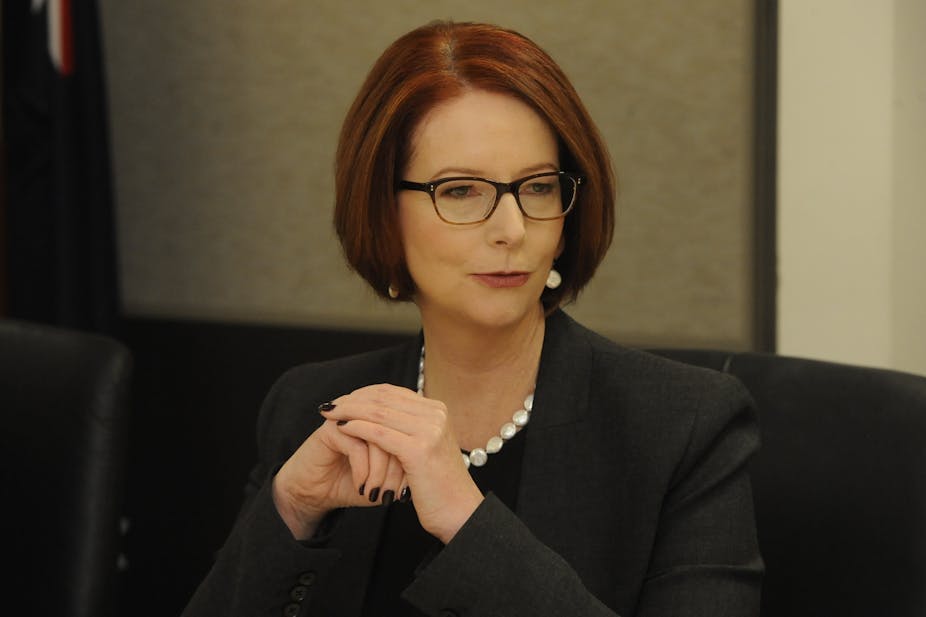On June 24, 2010, Australia’s first female prime minister, Julia Gillard, was sworn into office by Australia’s first female governor-general, Quentin Bryce. The iconic photographs of that day spoke of an occasion that was a long time coming.
In the three years to have passed since then, Gillard has been the victim of appalling levels of sexism not seen before in Australian public life. With some justification, therefore, she has made her gender a political issue. But has it been a proportional response to the misogynistic attacks meted out, or used simply for her own political gain?
By July 2011 a Facebook page had been created called “Julia Gillard – Worst PM in Australian history”. The iconic photo of the day Gillard was sworn in was now accompanied by obscene suggestions as to what the prime minister and the governor-general would do next.
And in 2012, after cartoons of her naked and wearing a dildo were emailed to all federal parliamentarians, Gillard finally started making public references to the sexism going viral on the internet. In October she made headlines around the world for her speech to parliament on sexism and misogyny.
Many in the Australian media reacted with outrage that the prime minister was drawing attention to the sexism experienced by women in public life. Critics attacked Gillard for “playing the gender card” – as though she should ignore this sexual vilification. But to remain silent would condemn others to experience the same treatment, just as silence over domestic violence still does.
Gillard had studiously ignored gender issues during the 2010 federal election, going so far as to “forget” to allocate a status of women portfolio immediately afterward. She was much more likely to don a hard hat than to identify as a feminist, despite being instrumental in changes of particular importance to women, such as the replacement of WorkChoices by Fair Work Australia.
What happened between 2010 and 2012? Gillard had been subjected to an unrelenting campaign of vilification by a loose coalition of shock jocks, bloggers and newspaper columnists.
The campaign has been rhetorically violent in nature at times. Talkback radio host Alan Jones suggested Gillard be put in a chaff bag and taken out to sea, presumably to drown. His justification was that she was a “liar”, having broken a campaign promise not to introduce a carbon tax.
Television watchers also saw a banner reading “Juliar…Bob Brown’s bitch” behind opposition leader Tony Abbott while speaking to an anti-carbon tax rally at Parliament House in 2011.

This lack of respect contrasts strongly with the treatment of Denmark’s first female prime minister, Helle Thorning-Schmidt, who took office in 2011. Thorning-Schmidt also headed a minority government and faced numerous accusations of broken election promises – but not of being a “liar” or someone’s “bitch”. She explained that the government had made a mistake in not making sufficiently clear that the election result demanded compromises.
In the past fortnight outrage has again been expressed over the prime minister’s speech to the launch of the Women for Gillard campaign. The speech was largely a summary of policy gains under Labor governments, including the Rudd and Gillard governments. It covered paid parental leave, the equal pay win by community service workers and the increase of the tax-free threshold to A$18,000 – of particular benefit to part-time and low-paid women workers.
What was extracted for media headlines was a clumsy warning about “men in blue ties” retaking centre stage in Australian politics, and a single sentence about abortion again becoming the “political plaything of men who think they know better”.
And yet, there has been little media attention to the drop in women’s political representation across Australia since 2009. For example, the fall of the Queensland Labor government in 2012 led to a drop in the number of women in that state’s parliament from 37% to 20%. Given Australia’s commitments to gender equality in public decision making this seems a fair point to raise.
Was it outrageous of Gillard to raise the issue of abortion? Given the halt to overseas aid for family planning during the Howard period, the ministerial veto on importation of RU486, and the federal funding of misleading pregnancy counselling services, this hardly seems an irrelevant concern.
Women mobilised across party lines on these issues to oppose the then-health minister Tony Abbott. The big gain from the inclusion of abortion in Gillard’s speech was a commitment by Abbott, now as opposition leader, not to do any deals to restrict the funding of abortion.
No reasonable person could argue that all the policies of the Gillard government have advanced gender equality. Cuts to public expenditure always have disproportionate impact on women. The shift of sole parents onto the Newstart Allowance was strongly resisted by elements within the parliamentary ALP.
But regardless of the reasons, the issue of gender equality has once again been put on the political agenda – where it should be, as long as women remain underpaid, underrepresented and at risk of violence from their intimate partners.

